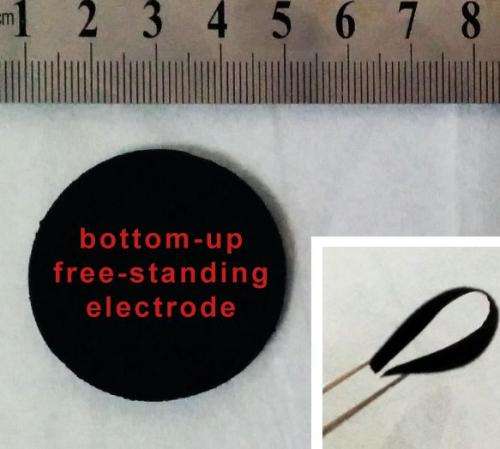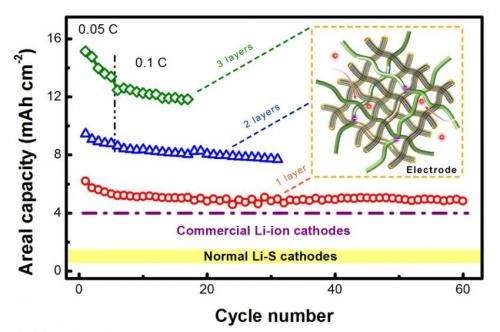Flexible paper electrodes with ultra-high loading for lithium-sulfur batteries

With the rapid development of portable electronic devices, electric automobiles, and renewable energy storage, high-density energy storage systems are needed. Lithium-ion batteries, though mature and widely utilized, have encountered the theoretical limit and therefore can not meet the urgent need for high energy density. Lithium-sulfur batteries, owning a theoretical energy density of 2600 Wh kg-1, which are approximately 4 times as much as commercially used lithium-ion batteries, are considered to be strong candidates. The abundance and environmentally friendly nature of the element sulfur as cathode material are factors in the huge potential of lithium-sulfur batteries. The combination of nanocarbon and sulfur is effective at overcoming the insulating nature of sulfur for lithium sulfur batteries.
"Due to excellent electrical conductivity, mechanical strength and chemical stability, nanocarbon materials have played an essential role in the area of advanced energy storage," said Dr. Qiang Zhang, associate professor in the Department of Chemical Engineering at Tsinghua University.
However, most contributions concerning carbon/sulfur composite cathodes possess a relatively low areal loading of sulfur of less than 2.0 mg cm-2, which prevented the full demonstration of the outstanding performance of C/S composite cathodes. "The areal capacity of commercially used lithium-ion batteries is about 4 mAh cm-2, and therefore, the areal loading of sulfur in the cathode of lithium-sulfur batteries needs to be greatly improved," said Qiang.
Recently, scientists from Tsinghua University have created a free-standing carbon nanotube paper electrode with high sulfur loading for lithium-sulfur batteries.
A bottom-up strategy was employed and a hierarchical structure was designed and achieved.
"We select carbon nanotube (CNT) as the building block", Qiang told Phys.org, "CNTs are one of the most efficient and effective conductive fillers for electrode. We selected short multi-walled CNTs (MWCNTs) with lengths of 10-50 μm as the shortrange electrical conductive network to support sulfur, as well as super long CNTs with lengths of 1000-2000 μm from vertically aligned CNTs (VACNTs) as both long-range conductive networks and inter-penetrated binders for the hierarchical free-standing paper electrode."

"We develop a bottom-up routine in which sulfur was firstly well dispersed into the MWCNT network to obtain MWCNT@S building blocks and then MWCNT@S and VACNTs were assembled into macro-CNT-S films via the dispersion in ethanol followed by vacuum filtration", Zhe Yuan, a student in Tsinghua University, explained, "Such sulfur electrodes with hierarchical CNT scaffolds can accommodate over 5 to 10 times the sulfur species compared with conventional electrodes on metal foil current collectors while maintaining the high utilization level of sulfur."
In most reported Li-S cells, aluminum foil was used as current collector and a routine slurry-coating procedure was widely used. However, there was a ratio of 10 to 50 wt % of binders, conductive agents, as well as modifying precursors in the electrode, which neutralized the advantage of Li-S system in high specific capacity.
Herein, no aluminum foil or binders were employed in this research.
"An initial discharge capacity of 6.2 mAh cm-2 (995 mAh g-1), a 60 % utilization of sulfur, and a slow cyclic fading rate of 0.20 %/cyc within the initial 150 cycles at a low current density of 0.05 C were achieved," says co-author Jia-Qi Huang of Tsinghua University. "The areal capacity can be further increased to 15.1 mAh cm-2 by stacking three CNT-S paper electrodes, with an areal sulfur loading of 17.3 mg cm-2 as the cathode in a Li-S cell." This work was published on Volume 24, Issue 39 of Advanced Functional Material on Oct 22, 2014.
This proof-of-concept experiment indicates that the rational design of the nanostructured electrode offers the possibility of the efficient use of active materials as practical loading. "The current bottom-up electrode fabrication procedure is effective for the preparation of large-scale flexible paper electrodes with good distribution of all functional compounds, which is also favorable for graphene, CNT-graphene, CNTmetal oxide based flexible electrodes," Qiang said. "The as-obtained free-standing paper electrode is promising for the ubiquitous applications of Li-S batteries with low cost, high energy densities for future flexible electronic devices such as smart electronics and roll-up displays."
More information: Yuan Z, Peng HJ, Huang JQ, Liu XY, Wang DW, Cheng XB, Zhang Q, "Hierarchical free-standing carbon nanotube paper electrodes with ultrahigh sulfur loading for lithium-sulfur batteries." Advanced Functional Materials, 2014, 24(39), 6105-6112. DOI: 10.1002/adfm.201401501
Journal information: Advanced Functional Materials
Provided by Tsinghua University



















